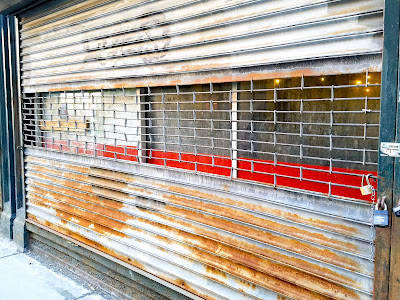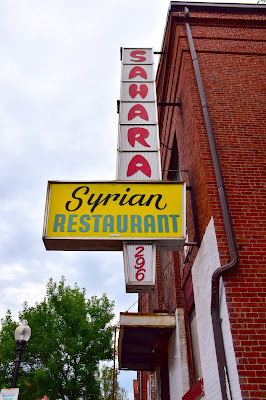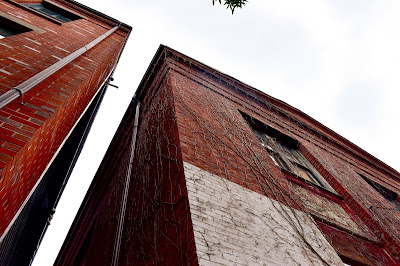From Dave Brigham:
I once got propositioned by a hooker in Boston's Chinatown. I was walking from my office in the nearby Leather District toward the subway on Boylston Street when I was accosted by a pimp. He hooked his arm into mine and asked if I was looking for a good time. I was stunned and didn't say anything right away. "You cool, man?" he asked. I assured him I was. Then he fell back and one of his ladies linked arms with me as I walked down the street, never breaking stride. She told me that if I had a big enough John Thomas, then maybe she would give me a freebie. I told her "No thanks," and she slipped back into the crowd.
It happened right around here, along Essex Street near the Verizon building.

Or maybe it wasn't here. Anyway, let's talk about the Verizon building first, and then Chinatown in general. Built in 1919 as a New England Telephone & Telegraph central switching station, the property at the corner of Essex Street and Harrison Avenue is jammed with telecommunications equipment. The top three floors, however, are no longer needed for this purpose, so a developer has proposed converting that space to 46 apartments, and renovating the lobby to add a mailroom, trash and recycling area, bike storage and other tenant-friendly features. You know the Boston apartment/condo/hotel market is hot when developers want to stack people on top of five floors of high-tech ballyhoodles, Fitzenheimer machines, gunkle switches and other made-up spy equipment.
This development was put before the city in November 2016, and I believe it's under construction now. While not a large development, this project is one of many that are changing the face of Chinatown.
As I've documented numerous times on this blog, Boston is a city in flux, with residential and hotel skyscrapers and office/retail buildings rising throughout the city. Chinatown, which began to take shape in the 1870s in an area formerly occupied by a succession of Irish, Jewish, Italian and other immigrants, is a relatively small neighborhood, with a population at the 2010 census of fewer than 4,500 people. In the last 10 years, as more apartment and condo buildings have risen in the area, that number has surely gone up, although the percentage of Asian residents has declined, per Wikipedia.
The buildings that have been lost or radically changed in Chinatown in recent years include the Dainty Dot Hosiery building (see October 9, 2012, "Window Dressing") and the Hong Lok House (see April 6, 2019, "UPDATE: Cashing Out (And Learning About Facadism").
While there are changes afoot in Chinatown, the neighborhood still has an overwhelming Asian feel, with dozens of restaurants, small shops, community centers and other facilities.
The Verizon building also backs up to Oxford Street. On the opposite corner of Oxford and Essex I spied this ghost sign for a market that used to be here.

Here's the front of the old store, which I believe was called Cheng Kwong Market.

Another memory from the days when I regularly walked through here from work to the subway: I recall seeing delivery trucks parked outside the market, and buckets and boxes of produce and fresh fish piled up in front. How fresh? On at least one occasion I saw fish flopping around on the sidewalk, having escaped the boxes of ice they were packed in. A last gasp.
I found a thread at ArchBoston.org that discusses a proposed limited-service hotel for the Cheng Kwong Market site. Curbed Boston listed this proposed project at #4 on a 2017 posting of "Boston's Most Controversial Developments." I'm not sure the status of the proposal.

Next to the market, in a separate building, was Chau Chow City, a restaurant that closed in 2017 after 20 years at this spot, due to raised rents. The restaurant building appears not to be part of the above-mentioned project. I'm not sure what the fate of this place, at 83 Essex Street, is. Known as the Pelham Building, and dating to at least 1899, it was designed by Stephen R.H. Codman, whose firm also designed the Peter Bent Brigham Hospital (now part of Brigham & Women's), a building at 134-142 Portland Street in Boston's North Station area and 7-11 Merchants Row near Quincy Market, among others.
Continuing east along Essex Street I found this ghost sign.
At the corner of Essex and Kingston streets is the former location of Bartlett, Coppinger and Maloon dry goods firm. I have found very little about this company online. The building is home to offices, furniture and kitchen showroom Studio Verticale and other businesses. It is located across Kingston Street from the former site of the aforementioned Dainty Dot Hosiery building.
Around the corner on Surface Road, barely still in Chinatown, I found this sculpture celebrating the Year of the Pig - 2019. The artist is Elliott Kayser, who seems to have a thing for sculpting animals.
Heading south on Surface Road and through the famous Chinatown Gate, I found Hot Pot Buffett, in a building that also houses a Kung Fu studio. Open since 2010, the restaurant is located in the former space of Imperial Tea House.

Across the street is Great Taste bakery and restaurant.

I'm not sure the age of the older buildings in Chinatown, but surely some of them date back to at least the mid-19th century. Before Chinese immigrants began making their homes in this area, the neighborhood was home to new Americans of Irish, Jewish and Italian descent. Certain streets in Chinatown are as narrow as those in other older neighborhoods of the city, such as the North End and Beacon Hill. It's those areas that are the most vibrant, as residents and businesspeople bump up against tourists and those seeking out good restaurants, bakeries and bars.
Below is an example of one of these older buildings I'm talking about.

You can see the ghost of a smaller building at the corner of Oxford and Beach streets, above this restaurant. A follower of The Backside of America Instagram in March said of this photo that this building and others in Chinatown may date back as far as the 1830s.
Not too far away, at the corner of Kneeland and Knapp streets I found a ghost of a different kind:

Based on my admittedly unprofessional perusal of old maps online, I believe this building, like many in Chinatown, is a former garment district facility. Garment and leather factories cropped up in this area after Boston's fire of 1872. "In 1898, sweatshops operating in tenements (mostly North and West Ends) were outlawed and work moved to loft factories," according to this Chinatown Atlas article. "The industry expanded in the late 19th century south towards Essex St. At the same time, Chinatown was establishing itself on Harrison Ave. between Essex and Beach Streets."
As Chinatown grew, the need for a community space increased. The Boylston Building, below, located at the corner of Boylston and Washington streets, was built in 1887 and originally housed the Boylston Market. At some point that I haven't been able to pin down, the building became the China Trade Center. In addition to a new, temporary branch of the Boston library, the center is "home to numerous non-profit agencies that provide essential services to Chinatown residents, including the International Institute of New England, the Urban College of Boston and Health Resources in Action," per this press release from the Boston Planning & Development Agency, which owns the building.

Just up the street from the trade center, at the outer fringe of Chinatown, is the Grand Lodge of Massachusetts Freemasons. I really like the handle on the door (below) of the building, which dates to 1898 and is the third grand lodge to stand at this site.
Cutting behind the China Trade Center is an alleyway -- Marty's Way -- that at first I thought was a dead end. But it enticed me with this giant poster, so I kept walking.

"THE GAIETY THEATRE
1000 LAUGHS
DANDY DANCES
A DOZEN SONG HITS
& A CHORUS OF GLORIOUS GIRLS"
So like any other fool looking for a good time, I followed the path, which led me to....

....a plaque. OK, so I knew the Gaiety Theatre was long gone but I was hoping for more than a window box exhibit. The theater opened in 1908 with a capacity for 1,700 patrons, and featured vaudeville and burlesque shows over the years. It was razed in 2005; I probably walked past it back in the days when I was getting propositioned. Now an apartment tower called The Kensington stands on the spot.
Along Essex Street I saw this gate keeping folks out of whatever shuttered store or restaurant was located here, in the massive Washington-Essex Building.

Built in 1905 as the Siegel's Department Store, the Washington-Essex Building (below) is currently home to several State offices, including the Massachusetts Commission for the Blind, the Department of Medical Assistance, the Department of Industrial Accidents and the Department of Transitional Assistance.

In the 1920s, the building featured a temporary version of Keith's Boston Theatre, which hosted vaudeville shows among other entertainments. For more about impresario B.F. Keith and his position as the founder of vaudeville, see ??? "In Boston, A Nod to Vaudeville's History."
As I mentioned above, Chinatown has seen its share of development in recent years. As with development anywhere, even in change-crazy Boston, things take time. Over on Beach Street, so named because in the days before this part of town was filled in, it was along the water, I found this great ghost sign.

This is 17-23 Beach Street, which dates to 1899 and until recently was home to Pho Mai Restaurant and numerous offices on its upper floors. The banner is for a place called Eat Pho, which doesn't appear to have opened. The ghost sign is for Mass. Medical Office; I'm not sure when that business closed. Back to my point above about development: two years ago developer Beach Street Trust proposed converting the building into apartments for working-class residents. I haven't been able to find any news about this proposed project since the initial announcement.
OK, let's get to some restaurants, a big reason many people visit Chinatown. There are loads of great signs for all these eateries. Here are just a few. I wish I had more to show you.

Located on Tyler Street, China Pearl specializes in dim sum carts. I don't really know what that means.

Jade Garden is also located on Tyler Street.

Guess where Peach Farm, above, is located? If you guessed Tyler Street, you win! This place is (or at least was, according to this 2014 article) a major hangout for local chefs and bartenders to chill, eat and drink after work.

New Jumbo Seafood Restaurant is located on Hudson Street.
Now, since this is the Backside of America, I need to feature old signs for long-gone places.

I haven't been able to find out much about China Pavilion. A 1978 City of Boston document I found online lists the restaurant among countless other businesses in this neighborhood. The sign above is on the back of a building on Surface Road, advertising a place on nearby Hudson Street, site of a recent archeological dig.
Below is a terrific ghost sign on Kneeland Street.

Gamsun Restaurant (translated as "Gold Mountain") operated in the 1940's and '50s from what I've found online. I love that this sign is still here and shines nearly as bright as a stack of gold bars.
Also located along Tyler Street, the purple bus below serves as mini-billboard for a bus service running between Boston and New York.

I wish the photo below was better. Located at Oxford Place Playground, it depicts a fantastic mural of a traditional Chinese scene, with beautiful trees, mountains, a river and men on horses crossing a bridge. For a better picture, click this link.

OK, my tour has come to an end. As with any town, city or neighborhood I've surveyed, I can't hit every cool feature. I'll probably swing through Chinatown again before too long. I'll leave you with this cool street light along Kneeland Street, something I can't believe I'd never noticed before.

Here's your headline explainer:

















